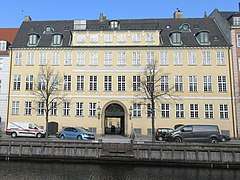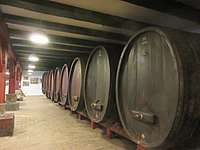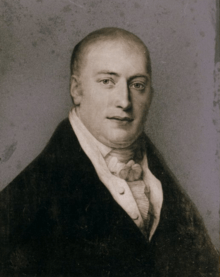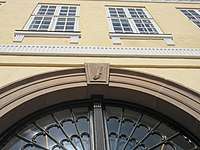Heering House
The Heering House (Danish: Heerings Gård) is a Neoclassical house overlooking Christianshavn Canal in the Christianshavn neighbourhood of Copenhagen, Denmark. It takes its name after Peter Frederik Suhm Heering (1792-1875) who owned it from 1838 until his death in 1875 and it continued to serve as headquarters for his company, Peter Heering, until 1977. The building is now home to the Nordea Foundation and a museum dedicated to banks and saving banks, as well as six residences available to foreign researchers and specialists. [1]
| Heering House | |
|---|---|
Heerings Gård | |
 The building seen from across the canal | |

| |
| General information | |
| Architectural style | Neoclassical |
| Location | Copenhagen, Denmark |
| Country | Denmark |
| Coordinates | 55°40′19.95″N 12°35′23.08″E |
| Completed | 1785 |
| Client | Hans Peder Kofoed |
| Owner | Nordea Foundation |
| Design and construction | |
| Architect | G. E. Rosenberg |
History
Early history
A brewery was built at the site in 1753. In 1785 it was acquired by Hans Peder Kofoed (1743– 1812), a sea captain from Bornholm, who constructed a large house towards the street. It was probably designed by the architect Georg Erdman Rosenberg. Kofoed lived in the building with his wife, Marie Kofoed (1760 - 1838), and an adopted son from Saint Croix. [2]
When Marie Kofoed became a widow in 1812, she involved herself in philanthropic work in the local community, supporting unmarried women and widows of seamen financially, and continued to live in the house until her own death in 1838.[3]
The Heering era
.png)
The house was then purchased by Peter Frederik Suhm Heering who needed more space for his expanding business enterprises. He had begun a production of Cherry Heering liqueur in 1818 which had gained world-wide success. In 1833 he had also made a move into shipping, acquiring a schooner built in Svaneke on Bornholm. And by 1858, his company, Heering Line, operated a fleet of ten merchant ships which sailed on South America and the Mediterranean Sea.
.png)
After Peter Heering's death in 1875, the property remained in the Heering family for another four generations.
Later history
In 1977 the property was purchased by the Private Bank (Privatbanken) in 1977. Parts of the building was then rented out to the Danish Ministry of Foreign Affairs. In 1999 the property changed hands once again when it was acquired by the Nordea Foundation. From 2008 to 2011 it underwent a DKK 100 mio. renovation.
Architecture
The main wing towards the street is built in the Neoclassical style. It is 16 bays long and consists of three storeys and a six-bay attica topped by a baluster-balustrade. A sculpted cow's claw on the ketstone above the gateway dates from the first owner of the house, Hans Peder Kofoed, and is a reference to his family name, Kofoed, which translates as "cow's foot" and is a name commonly associated with his native island of Bornholm.[3]
A lateral wing on the rear of the building was added in 1926-1927 to a design by Bent Helweg-Møller (1883-1956). It received an award from the City in 1929. The site also comprises the original brewery building which dates from 1759.[4] [5]
Nordea Foundation
The Nordea Foundation (Nordea-fonden) now has its secretariat in the building. The renovation also installed six residences which are available on grant to foreign researchers and specialists under the foundation's residence program.[6] [7]
Bank and Saving Museum

The Bank and Saving Museum (Bank- og Sparekassemuseet) was founded by the Private Bank at Børsen in 1857 to mark the 100-years anniversary of the bank's foundation. The displays include the former office of Carl Frederik Tietgen (1829–1901), the bank's founder and director over four decades, who has also been labelled as the most significant Danish entrepreneur of all times. After his death in 1901, the office was transferred to the bank's new headquarters at C.F. Tietgens Hus on Børsgade and left untouched until the opening of the museum. The museum also features a bank branch, complete with all inventory from c. 1900, and other artifacts from the history of the Danish bank sector. The museum also has a large exhibition space for changing exhibitions in an adjoining building. [8] [9] [10]
See also
References
- "Peter F Heering". diffordsguide.com. Retrieved October 1, 2019.
- "Marie Kofoed (1760-1838)". Dansk Kvindebiografisk Leksikon. Retrieved October 1, 2019.
- "Heerings Gaard". Nordea Fonden. Retrieved 2012-03-10.
- "Bent Helweg-Moller (1883-1956)". dphtrading.com. Retrieved October 1, 2019.
- "Overgaden Neden Vandet 11 / Wildersgade 12-18" (in Danish). indenforvoldene.dk. Archived from the original on 2016-03-04. Retrieved 2012-03-10.
- "About Nordea-fonden". Nordea-fonden. Retrieved October 1, 2019.
- "Residence Programme". Nordea Fonden. Retrieved 2012-04-12.
- Victor Andersen. "C. F. Tietgen". Den Store Danske, Gyldendal. Retrieved October 1, 2019.
- "Museets historie". Bank- og Sparekassemuseet. Archived from the original on 2013-02-12. Retrieved 2012-04-10.
- "The Bank and Savings Museum". kbhmuseer.dk. Retrieved October 1, 2019.
External links
- Official website of the Museum of Banks and Saving
- Renderings by Bent Helveg-Møller
- Image on Flicker
- Christiansbro
- Source

